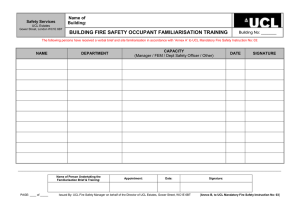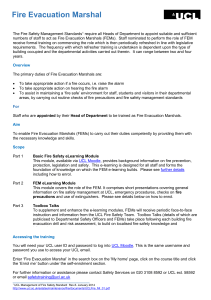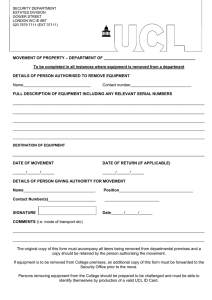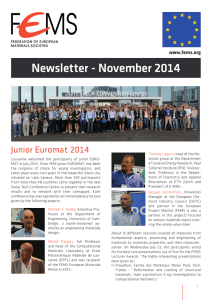UCL SENIOR & FIRE EVACUATION MARSHALS (FEM) GUIDANCE / TRAINING NOTES
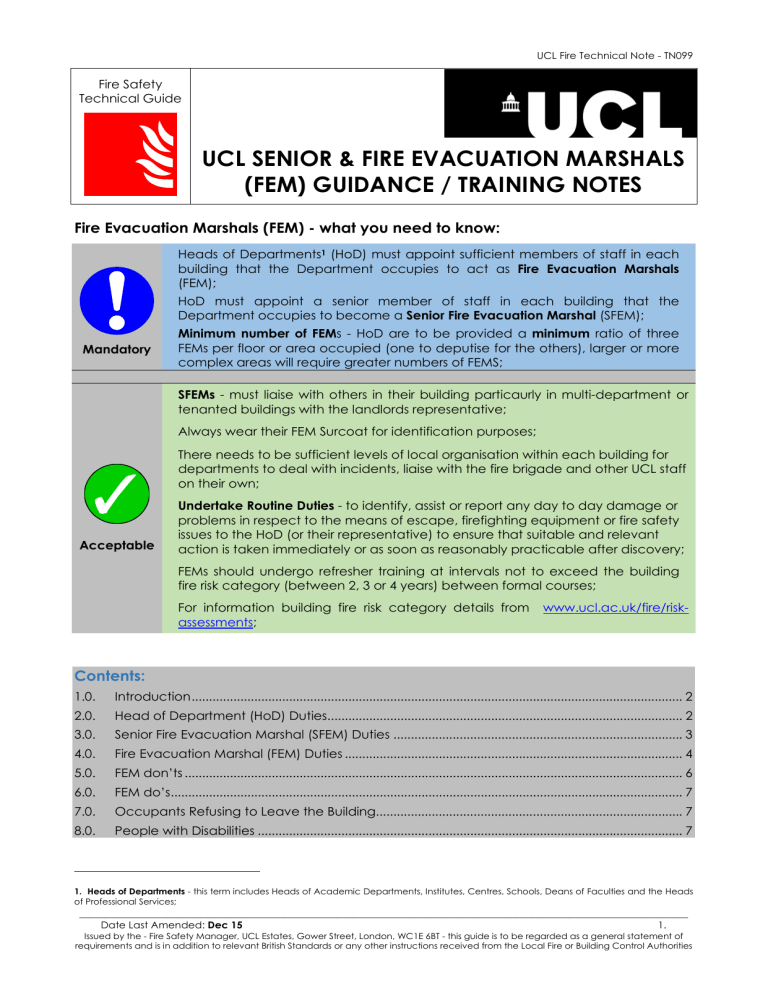
UCL Fire Technical Note - TN099
Fire Safety
Technical Guide
UCL SENIOR & FIRE EVACUATION MARSHALS
(FEM) GUIDANCE / TRAINING NOTES
Fire Evacuation Marshals (FEM) - what you need to know:
Mandatory
Heads of Departments 1 (HoD) must appoint sufficient members of staff in each building that the Department occupies to act as Fire Evacuation Marshals
(FEM);
HoD must appoint a senior member of staff in each building that the
Department occupies to become a Senior Fire Evacuation Marshal (SFEM);
Minimum number of FEMs - HoD are to be provided a minimum ratio of three
FEMs per floor or area occupied (one to deputise for the others), larger or more complex areas will require greater numbers of FEMS;
Acceptable
SFEMs - must liaise with others in their building particaurly in multi-department or tenanted buildings with the landlords representative;
Always wear their FEM Surcoat for identification purposes;
There needs to be sufficient levels of local organisation within each building for departments to deal with incidents, liaise with the fire brigade and other UCL staff on their own;
Undertake Routine Duties - to identify, assist or report any day to day damage or problems in respect to the means of escape, firefighting equipment or fire safety issues to the HoD (or their representative) to ensure that suitable and relevant action is taken immediately or as soon as reasonably practicable after discovery;
FEMs should undergo refresher training at intervals not to exceed the building fire risk category (between 2, 3 or 4 years) between formal courses;
For information building fire risk category details from www.ucl.ac.uk/fire/riskassessments ;
Contents:
1.0.
Introduction ............................................................................................................................................. 2
2.0.
Head of Department (HoD) Duties ...................................................................................................... 2
3.0.
Senior Fire Evacuation Marshal (SFEM) Duties ................................................................................... 3
4.0.
Fire Evacuation Marshal (FEM) Duties ................................................................................................. 4
5.0.
FEM don’ts ............................................................................................................................................... 6
6.0.
FEM do’s ................................................................................................................................................... 7
7.0.
Occupants Refusing to Leave the Building........................................................................................ 7
8.0.
People with Disabilities .......................................................................................................................... 7
1. Heads of Departments - this term includes Heads of Academic Departments, Institutes, Centres, Schools, Deans of Faculties and the Heads of Professional Services;
______________________________________________________________________________________________________________________
Date Last Amended: Dec 15 1.
Issued by the - Fire Safety Manager, UCL Estates, Gower Street, London, WC1E 6BT - this guide is to be regarded as a general statement of requirements and is in addition to relevant British Standards or any other instructions received from the Local Fire or Building Control Authorities
UCL Fire Technical Note - TN099
1.0. Introduction
1.1.
Due
to the size, numbers of staff employed by UCL, complexity of the Estate and associated Institutes; it is neither practical nor feasible to maintain a meaningful register of building occupants to account for those persons using premises during normal working hours. Therefore, the UCL Fire Safety
Management Standard 2 requires all Heads of Departments (HoDs) to designate and provide sufficient staff to act as Fire Evacuation Marshals
(FEMs). The Head of Department must also appoint a senior member of staff in each building that the Department occupies to become a Senior Fire
Evacuation Marshal (SFEM) plus suitable appointed deputy/deputies to ensure that a SFEM is on duty at all reasonable times.
1.2. Instructions and information for FEM duties are contained on Moodle
( www.ucl.ac.uk/moodle ) under FEM, and this training should be completed by all appointed fire marshals.
2.0. Head of Department (HoD) Duties
2.1. HoDs at UCL must nominate sufficient people to undertake FEM Duties as follows:
FEMs should be appointed based on a minimum of three persons per each floor / part of floor with larger numbers appointed for more complex areas requiring greater numbers;
HoDs must appoint an SFEM with adequate deputies in place to cover
absences from the nominated departmental FEMs for each building occupied by the department;
The role of the SFEM is relatively straightforward. Ultimately, they should receive confirmation of clearance of all areas from departmental FEMs and provide this information to the fire and rescue service on arrival;
SFEMs are to liaise with the department's FEMs, as well as other departmental SFEMs within the building if multi-occupied. They are to deal with and liaise with the fire brigade on their arrival and provide information relating to the evacuation (i.e. whether all persons have evacuated or if anyone has remained in the building) and guide them to the building Premises Information Box and fire alarm panel;
It is recommended that a member of staff who has a working knowledge of the layout, functions and hazards associated with the building or department’s activities (e.g. Department Safety Officer (DSO), Lab
Superintendent or Building Officer) be appointed as SFEMs.
2. See UCL Fire Safety Mandatory Instruction MI01 - the UCL Fire Safety Management Standard;
______________________________________________________________________________________________________________________
Date Last Amended: Dec 15 2.
Issued by the - Fire Safety Manager, UCL Estates, Gower Street, London, WC1E 6BT - this guide is to be regarded as a general statement of requirements and is in addition to relevant British Standards or any other instructions received from the Local Fire or Building Control Authorities
UCL Fire Technical Note - TN099
Appropriate training must be provided for FEMs on a regular basis with suitable records kept by the department;
FEMs should undergo refresher training at intervals not to exceed the building fire risk category (between 2, 3 or 4 years) between formal training;
The HoD will need to have arrangements in place to ensure that sufficient numbers of FEMs are maintained and trained at appropriate periods;
The HoD will need to arrange (perhaps through their DSO or
Departmental Administrator) to record names and locations of the departmental appointed FEMs on the riskNET ‘Responsible Persons’
Register.
3.0. Senior Fire Evacuation Marshal (SFEM) Duties
3.1. SFEM primary responsibilities are:
To co-ordinate information received from the departmental FEMs during an evacuation;
UCL building - to liaise within each building, if multi-occupied, with other departmental FEMs to ensure a nominated SFEM is on duty to give assistance to the fire brigade, security and maintenance staff at any incident;
Tenanted Buildings - to liaise within each building, if multi-occupied, with the Landlord’s agents or other occupiers giving assistance to the fire brigade and others as required.
Administer and organise the duties of the departments’ FEMs, as required;
3.2. There needs to be sufficient levels of local organisation within each building for departments to deal with incidents, liaise with the fire brigade and other
UCL staff on their own. This is an important task, as generally there may be no one else to take charge and resolve immediate problems resulting from a fire incident. The SFEM should identify themselves to the fire brigade and other persons in authority by wearing a surcoat or by a coloured safety helmet (red) or some other distinguishing marker.
3.3 SFEMs should ensure that the fire brigade officer in charge is aware of the provision of full building plans located in the building’s Premises Information
Box, and are made aware of the location of the fire alarm panel in order that the location of any activation is quickly identified.
______________________________________________________________________________________________________________________
Date Last Amended: Dec 15 3.
Issued by the - Fire Safety Manager, UCL Estates, Gower Street, London, WC1E 6BT - this guide is to be regarded as a general statement of requirements and is in addition to relevant British Standards or any other instructions received from the Local Fire or Building Control Authorities
UCL Fire Technical Note - TN099
4.0. Fire Evacuation Marshal (FEM) Duties
4.1. FEMs’ primary responsibilities are:
to sweep their areas of responsibility to ensure that all persons are accounted for and instructed to leave immediately by the nearest available fire exit;
to identify, assist or report the location of any individual in imminent danger or requiring assistance as necessary;
to act as ‘trained staff’ in the use fire extinguishers provided - only where safe & practical to do so;
Routine Duties - to identify, assist or report any day to day damage or problems in respect to the means of escape, fire-fighting equipment or fire safety issues to the HoD (or their representative) to ensure that suitable and relevant action is taken immediately or as soon as reasonably practicable after discovery. Such matters may include, but are not limited to: o
The condition of fire-resisting doors; o
Ensuring that fire doors are not wedged open; o
Fire detectors are unobstructed; o
Emergency lights appear to be in reasonable state of repair; o
Housekeeping standards are reasonable; o
Means of escape routes are clear and free of storage; o
Fire extinguishers are present in designated locations, etc.;
4.2. On notification or discovery of a fire, FEMs are to carry out the following duties in a safe, calm and positive manner:
wear their FEM Surcoat for identification purposes;
ensure that the alarm has been raised (if not already activated) by operating the nearest fire alarm (Red) manual call point and dialling on a UCL Extension 222 / (9)999 as appropriate;
start sweeping their area of responsibility requesting politely but firmly that all staff, students and visitors leave the building immediately by the nearest available fire exit route and proceed to the Fire Assembly Point;
additionally, sweep all ‘common / shared’ areas to ensure occupants have evacuated the building, including the following areas:
______________________________________________________________________________________________________________________
Date Last Amended: Dec 15 4.
Issued by the - Fire Safety Manager, UCL Estates, Gower Street, London, WC1E 6BT - this guide is to be regarded as a general statement of requirements and is in addition to relevant British Standards or any other instructions received from the Local Fire or Building Control Authorities
UCL Fire Technical Note - TN099 o offices and general work areas; o computer cluster rooms, seminar rooms and student write-up areas; o lecture theatres; o staff rest rooms and WC facilities;
Remind Lab occupants where hazardous processes are being used, to shut down safely and quickly before leaving the area/building. FEMs inform the SFEM or a Fire Brigade Officer of the potential hazard on leaving the building;
report to the Senior FEM on leaving the building with the following information: o the location and cause of the fire (if known) and any other relevant information; o that, their area of responsibility is clear, or, if persons are still left in their area, where and why they are still in the building (i.e. they refused to leave, dealing with hazardous process, etc.); o location of hazardous materials or processes to be identified to the
Fire Brigade on their arrival through the Senior FEM;
proceed to the fire assembly point, taking building occupants with you, however: o
In some buildings, it may be necessary for FEMs to assist by positioning themselves (if safe to do so) at entrances / exits to the building to prevent persons re-entering whilst the emergency evacuation is still in progress; o
Where evacuating directly onto busy roads, FEMs are to instruct occupants to keep on the pavements so as not to cause potential injuries / accidents by becoming involved in road traffic, vehicles, cyclists etc. – this may involve some dynamic management of crowds to ensure the safety of relevant persons;
inform occupants that they may re-enter the building when the Senior
FEM or the Fire Brigade have indicated that it is safe to do so; o
Remind the fire brigade that 'Building Plans' are available in the
Premises Information Boxes (PIB) located close to the main fire alarm panel;
4.3. To carry out their duties effectively, FEMs need to:
get to know and liaise with their Senior and fellow FEMs - even if they are from a different department;
______________________________________________________________________________________________________________________
Date Last Amended: Dec 15 5.
Issued by the - Fire Safety Manager, UCL Estates, Gower Street, London, WC1E 6BT - this guide is to be regarded as a general statement of requirements and is in addition to relevant British Standards or any other instructions received from the Local Fire or Building Control Authorities
UCL Fire Technical Note - TN099
Walk all escape routes in their area of responsibility, even if they are routes that are not often used regularly. If the doors are security alarmed, get security to isolate the alarms temporarily, as it is essential for
FEMs to know the immediate escape routes so that they can confidently send others that way in the event of an emergency evacuation;
if there are ‘locked or restricted‘ areas close by, have the security code from the department and find out who works in the area and familiarise yourself with the room layouts. If for security reasons, these rooms are
‘out of bounds’; then they MUST have their own dedicated FEMs;
be pro-active;
4.4. Assist in maintaining a ‘fire safe’ environment by carrying out regular checks of fire extinguishing equipment, escape routes for obstructions or storage and that fire doors are not wedged open etc. Take appropriate action to remove or resolve issues.
4.5. Be aware of all escape routes in your area and the means of opening the various types of door release mechanisms.
Further guidance is available from Fire Safety Technical Note - TN002 (Fire
Safety Web Site: www.ucl.ac.uk/fire ), as it provides information including photographs of the emergency fire escape door furniture (locks / push bars / brake glass units) etc.;
4.6. Report problems identified with fire safety equipment or procedures through the department safety officer in the first place. Alternatively, report this matter to another appropriate person such as the HoD or Departmental
Administrator (DA) as necessary.
Service Requests through the Estates Customer Services Centre, for issues relating to fire precautions such as doors, fire alarms, etc. can be raised through the UCL Estates homepage ( www.ucl.ac.uk/estates ).
Other Matters to Consider:
4.7. Obstructing Entrances - move occupants away from the entrances of buildings and move them to the Fire Assembly Point (to allow the Fire
Brigade access), as there be a risk of explosion, debris or falling glass on people near the building.
4.8. Fire Assembly Point - help to prevent obstruct of roads or pavements.
DO NOT re-enter the building until told, even if the alarm bells are silenced;
______________________________________________________________________________________________________________________
Date Last Amended: Dec 15 6.
Issued by the - Fire Safety Manager, UCL Estates, Gower Street, London, WC1E 6BT - this guide is to be regarded as a general statement of requirements and is in addition to relevant British Standards or any other instructions received from the Local Fire or Building Control Authorities
UCL Fire Technical Note - TN099
Note – bells/sounders being silenced DOES NOT necessarily mean that the incident is finished, the fire brigade have silenced the bells while they search the building to protect their hearing or so as not to interfere with their personal radios;
DO NOT re-enter the building to carry out your duties: o if you are already outside and the bells are ringing (i.e. if you just arrived at work or from lunch), leave your area to other FEMs to check
(suitable deputies should have already been appointed); o assist by checking that your staff have been accounted for at the Fire
Assembly Point and pass relevant information on to the Senior FEM etc.;
DO NOT travel to other areas of the building to carry out your FEM duties, leave to the appropriate FEM for that area - you may become trapped or overcome smoke;
DO NOT get into arguments or distracted from your task;
6.0. FEM do’s
DO wear your Hi-Vis Surcoat as identification and as a mark of your authority;
Do encourage occupants to leave the building as quickly as possible and by the most direct route;
Do continue to move staff & students on leaving the building - to the
ASSEMBLY POINT;
DO NOT argue with them;
Note the room details or the area where you last saw them;
Inform SFEM or Fire Brigade Officer in Charge on leaving building details.
8.1. Head of Departments have a ‘duty of care’ to persons with disabilities or
Mobility Impaired Persons (MIP) to ensure that staff, students or regular visitors who need assistance in the event of an emergency are identified and arrangements for their safe evacuation put in place.
______________________________________________________________________________________________________________________
Date Last Amended: Dec 15 7.
Issued by the - Fire Safety Manager, UCL Estates, Gower Street, London, WC1E 6BT - this guide is to be regarded as a general statement of requirements and is in addition to relevant British Standards or any other instructions received from the Local Fire or Building Control Authorities
UCL Fire Technical Note - TN099
8.2. To assist in this process a Disability Emergency Egress Risk Assessment and a
Personal Emergency Evacuation Plan (PEEP) - available from the Fire Safety
Web www.ucl.ac.uk/fire - see UCL Fire Technical Notes TN009 / TN010 - completed. This will help identify suitable managerial and practical assistance to those disabled persons to achieve safe egress from the building in the event of a fire emergency by establishing:
How their disability might affect the fire evacuation of themselves and others;
Whether they can they make their own way out or, if assistance is required, how this will be provided;
Whether they will they need to be placed in a Safe Refuge (temporarily, whilst a suitable evacuation arrangement is implemented) or other steps need to be taken to ensure their safe evacuation;
Who will accompany and escort the disabled person out of the building, if a Refuge is to be used as part of the evacuation plan;
______________________________________________________________________________________________________________________
Date Last Amended: Dec 15 8.
Issued by the - Fire Safety Manager, UCL Estates, Gower Street, London, WC1E 6BT - this guide is to be regarded as a general statement of requirements and is in addition to relevant British Standards or any other instructions received from the Local Fire or Building Control Authorities


